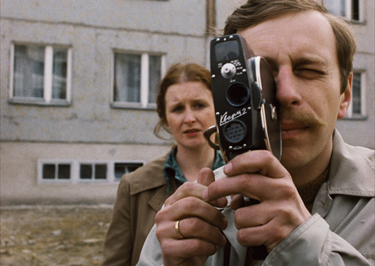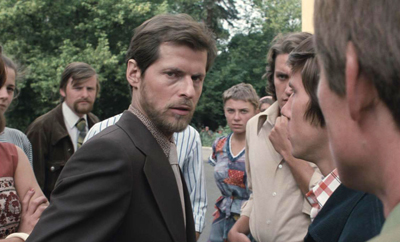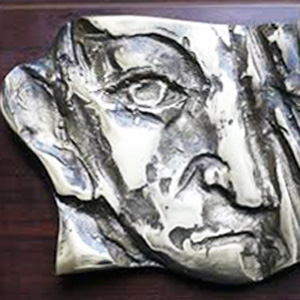
Still from the digitally reconstructed “Camouflage”
Dir. Krzysztof Zanussi.
Courtesy of the distributor.
Camouflage (1977)
Directed by Krzysztof Zanussi
Cinematography: Edward Kłosiński
Production design: Tadeusz Wybult
Music: Wojciech Kilar
Film editing: Urszula Śliwińska
© Studio Filmowe
Masterpieces of Polish Cinema distributed by Milestone Films
René Debos, the eminent American microbiologist and environmentalist, once poignantly commented that while the increasing pollution of the environment is deeply worrisome, even worse is the possibility that we will somehow adapt to it. Accompanying this warning was a drawing of a hypothetical human with an elongated nose and heavy eyebrows, two adaptations to air pollution developed over time. The result is a being whose adaptive deformity produces an involuntary shudder in the viewer: something essential to our humanity has been lost.
In the view of most citizens of communist Poland, including artists and academics, the country suffered under the effects of an ensemble of cultural, social, and political toxicity from 1944 to 1989. Already by 1951, Czesław Miłosz, in The Captive Mind, had described the manner by which the communist state and state-dictated pseudo-science of dialectic materialism had begun to corrupt the consciousness of both followers and non-followers. Susceptibility differed according to the relative presence or absence of one’s personal, artistic, and intellectual integrity, courage, religious conviction, and discerning nose for toxicity. Results spanned the spectrum from true believers, careerists, and opportunists, to external and internal exiles, to surreptitious and open opponents and passive aggressors.

A still from “Camera Buff”
Dir. Krzysztof Kieślowski
In the late 1970s a group of narrative and documentary filmmakers and films, including Krzysztof Zanussi (Camouflage, 1977), Feliks Falk (Top Dog, 1978), Andrzej Wajda (Man of Marble, 1977), Marcel Łoziński (Microphone Test, 1980) and Krzysztof Kieślowski (Camera Buff, 1979) took up cinematic investigations of the kind of concerns that had motivated Miłosz’s book, and that were widespread among the opposition during the latter period of the reign of Edward Gierek (1970 to 1980). This group is often labeled the “cinema of moral concern” or the “cinema of distrust”, and it had its eye fixed steadily and sometimes stealthily on the gaps between the communist rhetoric and the reality of life as it [i.e., the reality] was experienced by the majority of Polish citizens.
Zanussi’s Camouflage has been relatively unavailable in the English-speaking world until recently. Last year it was released separately in the U.K. , and now in the U.S. in a series of canonical Polish films gathered by Martin Scorsese and distributed by Milestone Films. The increased availability of this important film is most welcome, because, while its story concerns academic life in late 1970s Poland, current viewers in the U.S. and elsewhere will recognize parallels in contemporary political and academic cultures. The corruption of consciousness and the deformation of our humanity is an ever-present danger and too-frequent reality in human societies, communist and non-communist.

Still from the digitally reconstructed “Camouflage”
Dir. Krzysztof Zanussi
Camouflage ostensibly narrates the events of a summer linguistics camp for university students, but, only slightly covertly, the camp functions as a microcosm for the dynamics operating in the wider communist society. In keeping with the way that parts stand for the whole, characters, environments, and events here have a typicality which allows the viewer to discern what they are typical of in the society as a whole. Thus, we see immediately that this is a strictly hierarchical environment, where kowtowing, cronyism, privilege without merit, smug cynicism, sexual politics, venality, and the hiding of one’s true feelings that Miłosz called “ketman” govern behavior at the higher reaches of the hierarchy. Among the students, angry cynicism and moments of open rebellion reign—and the case of one student whose rational reaction to this maddening world is a lucid episode of madness. In the middle resides a hapless graduate assistant whose integrity and equanimity are sorely tested and finally, albeit temporarily, breached by the camp supervisor, a well-seasoned faculty veteran of the communist version of social Darwinism and the survival of the fittest that we see played out among the top echelon of this academic society. To point the audience toward this “natural history” function of the film, Zanussi begins the film with painted illustrations of animals, many of them cold-blooded, and sharply jabbing music by Wojciech Kilar. The motif of the hunter and the hunted flows through the body of the narrative, accompanied by the intermittent appearances of a cat. Zanussi provides occasional editorial counter-weights to this image of the calculating and predatory nature of communist society, giving us freely flying birds, beautiful ambient birdsong, nude swimmers, and a stand of clover in summer blossom, whose nectar a delicate butterfly is imbibing.
The narrative circles around and through the ongoing conversation between the faculty supervisor and graduate assistant. The catalyst for this nuanced intellectual contest between the supervisor’s bored and predatory cynicism and the assistant’s ideals of fair play and merit is the latter’s acceptance of a late essay by a student from Toruń. The assistant’s ethical position is tagged conservative and naïve by the supervisor, i.e., rooted in pre-communist Poland and, probably, the Catholic Church.
But, like many public aspects of communist Poland, things are not quite what they seem. Rules are rules says the supervisor, but subsequent conversations and actions within the larger group, including the late arriving Provost and his trophy wife, reveal that rules are made, changed, and voided at the whim and convenience of those high in the pecking order. We learn that the Provost dislikes the student’s Toruń professor, who was pointedly left off the list of professors invited to jury the essays of the students. As the onion is peeled more deeply, we learn that the linguistics research at Toruń is politically incorrect. Its support of a “nativistic” view of language violates the Marxist dogma that the mind comes into the world as a tabula rasa that can be wholly determined by the environment. To deny that determinate power of the environment is, by implication, to bring into question the “scientific” validity and efficacy of the communist establishment’s social engineering of the hearts and minds of Polish citizens.
All of this is understated, but there for the viewer to unpack by following the process of implication. Zanussi thereby provides his viewer with valuable exercises in unmasking the camouflage under which the communist system in Poland—and elsewhere—operated. His exercises in this regard are considerably less overt that those provided by Wajda’s Man of Marble and Falk’s Top Dog, valuable in their own manner. However, Zanussi’s approach marks him as more insidiously dangerous to those in power.
Perhaps the film’s key scene of sly unmasking is the supervisor’s remarks prefatory to the handing out of the prizes in the rigged contest. His delivery, and the knowing reaction of the Provost and his cronies, reveals that his oily prattle about the noble search for truth is a piece of utterly insincere, but politically correct, theatre. Because he is aware that his speech is a mask which camouflages the real truth, it is an example of Miłosz’s “ketman”—the camouflaging of one’s true identity for opportunist gain, and, ultimately, survival. Moreover, it is a witty parody of the kind of utopian rhetoric served up in socialist realist art, whose deep disconnection with reality produced angry cynicism in its victims, and various degrees and kinds of corrupt consciousness in those who chose, or were forced, to manufacture it.
Lastly, in an echo of the jury’s criticism of “nativism”, the key scene between the supervisor and the assistant finds the supervisor bringing to bear his sophistic skills to convince the assistant that his conservative and naïve conscience can be liberated by “self-conscience”. By “self-conscience” he means—in the fashion of Orwellian doublespeak—one’s desire to adapt to, and survive in, this toxic social system. It means the corruption of one’s entire consciousness, and the deformation of one’s humanity. The student’s integrity and grit survives this offer of the communist apple here and in the film’s last scene, where the struggle erupts into overtly physical and killing struggle. Undoubtedly, the details of this last scene should remain undisclosed here, in order to await the readers’ own discovery of the ending of this deeply humane film.
CR



